- History / Culture
- Gourmet
- Experiences
- Hot Springs
No.f_0003
Enjoying Hot Springs with Over 1,300 Years of History
Japan has the most hot spring areas in the world.
“Hadaka no tsukiai,” or the camaraderie of shared nudity, is a common Japanese expression.
It is a metaphor to symbolize open and honest relationships in which nothing is kept hidden. It is also used literally to describe how friends and family bathe together unclothed in communal baths, helping to bridge emotional distances. The expression embodies Japan’s deeply embedded communal bathing culture. Onsen, or hot springs, are one of the many facilities that have long served as a space for this essential communal activity.
With over 3,000 hot spring areas scattered across the country, Japan is the world's most famous hot spring country. Hot springs have a long history in Japan, with historical records dating back over 1,300 years. In those ancient times, the nobility sought healing and rejuvenation through the practice of “toji,” treating ailments and maintaining health by soaking in hot springs. Later, this practice spread from royalty to the other classes. For example, the samurai or the warrior class used it to mend wounds in wartime.
While it is now mainly used for relaxation and stress relief, it played a pivotal role in physical healing when medicine was still underdeveloped.
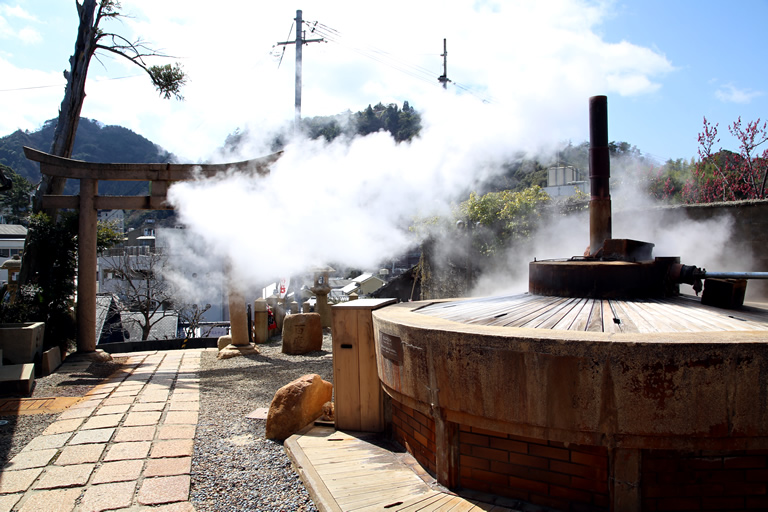
Steam rises at the source of hot springs, where heated groundwater emerges. This is the Tenjin Sengen, a hot spring source at Arima Onsen. ©KOBE TOURISM BUREAU
Today, the health benefits of onsen have been scientifically analyzed.
The water pressure and buoyant forces offer a natural form of massage, soothing tired muscles and aching joints. Hot springs are also rich in various minerals and compounds, providing a holistic remedy for the body. Hot springs are the best way to revitalize travelers after a long day of exploration on foot.
For those who are averse to revealing their body to a room full of strangers, you can choose from the many modern hot spring resorts offering private open-air baths in the comfort of your own room and baths that can be rented out for exclusive access.
"Arima Onsen" boasts a legacy spanning over 1,300 years.
Among Japan's many well-established hot spring areas, the three oldest are revered as the "Three Ancient Hot Springs of Japan." One of these three is Arima Onsen in Hyogo Prefecture. In fact, the oldest official literature in Japan states that Emperor Jomei himself indulged in the hot springs of Arima Onsen as early as 631 AD.
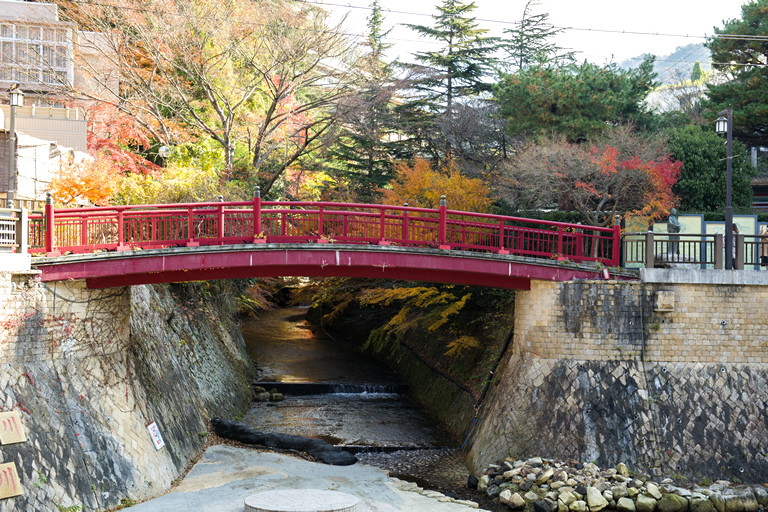
The Nene Bridge exudes the charms of the hot spring resort. “Nene” is the name of a prominent 16th-century female figure linked to Arima Onsen's storied past. ©KOBE TOURISM BUREAU
With a history spanning over 1,300 years, Arima Onsen in Hyogo Prefecture is steeped in countless legends and tales.
Among them is the fabled origin of Arima Onsen. It began when two deities observed three wounded crows bathing in the hot spring's waters. Within days, the crows' injuries miraculously healed, leading to the belief that these springs possessed extraordinary healing powers.
Another captivating tale dates back to 1097 when a devastating flood ravaged Arima, leaving the town in ruins. In response to divine guidance, a monk arrived to rebuild both the hot springs and the surrounding temples. To accommodate pilgrims seeking solace and travelers seeking healing, the monk established twelve lodging houses known as "shuku-bo." Even today, echoes of this history persist, with many of the 30-odd accommodations in the Arima Onsen area bearing names like "Gosho-bo" and "Naka-no-bo," honoring their roots in this inspirational tale.
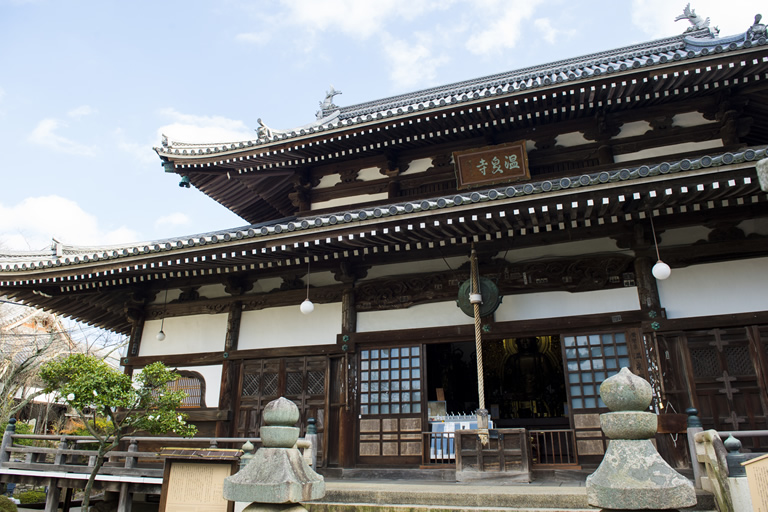
Onsenji Temple was founded in 724 AD and rebuilt in 1097 AD. ©KOBE TOURISM BUREAU
Arima Onsen, A Global Rarity
Apart from its illustrious history, Arima Onsen also boasts one of the rarest hot spring properties in the world.
Japan recognizes nine distinct therapeutic hot spring properties, and the hot spring water at Arima Onsen features a remarkable blend of seven of those properties.
Moreover, the Arima Onsen area has two different types of hot springs for visitors to indulge in: the reddish-brown “Kin-no-yu” (Golden Spring) and the clear, colorless “Gin-no-yu” (Silver Spring). The Golden Spring, rich in iron and salt, forms a delicate film on the skin, offering prolonged moisturization. On the other hand, the Silver Spring presents two variations: one rich in carbon dioxide, promoting blood circulation when immersed in and increasing appetite when consumed, and another infused with radon, believed to enhance the body's natural ability to heal.
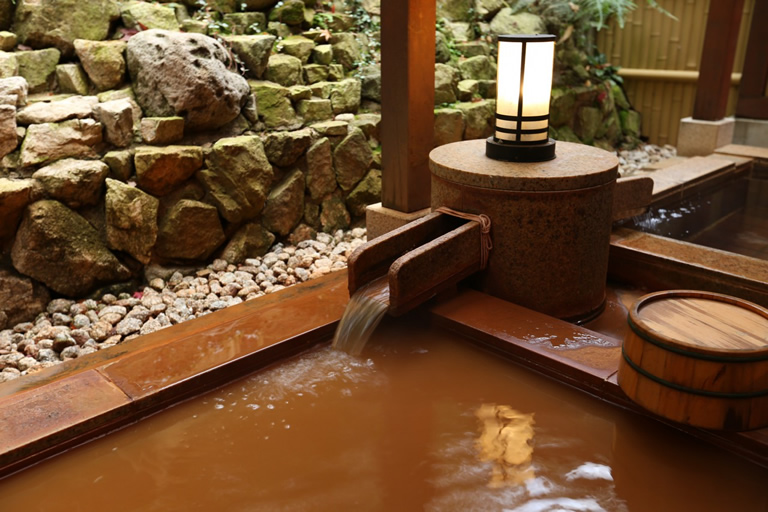
The Golden Spring. With a high iron content, the water immediately turns reddish brown when it comes in contact with the air.
If you want to enjoy the Arima Onsen area without going out of your way, try dipping your toes into one of the foot baths.
Just a short six-minute stroll from Arima Onsen Station lies "Kin no Yu," a public bathing facility with no accommodations, allowing visitors to enjoy soaking in hot springs for a reasonable price. Outside, a complimentary foot bath awaits, where a mere 15 minutes of soaking will leave you feeling nice and warm and light-footed.
If you don’t mind bathing nude with others, do venture into the public bath in addition to the foot bath. A mere three-minute walk from Kin no Yu lies "Gin no Yu," offering a chance to explore the differences between Arima's two distinct hot spring waters.
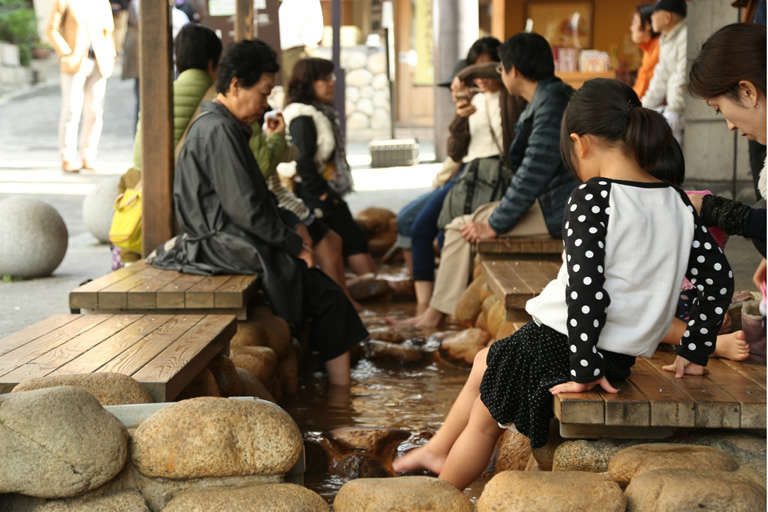
Kin no Yu's complimentary foot bath.
Arima’s Charms Extend Beyond the Hot Springs
Hot spring baths are not the only attractions in Arima. Enjoy a stroll through Arima and appreciate the architecture of the traditional Japanese wooden houses that fit in harmoniously among the natural surroundings. As you wander, indulge in traditional Japanese snacks like “manju (flour pastry)” and "senbei (rice crackers)" from local vendors.
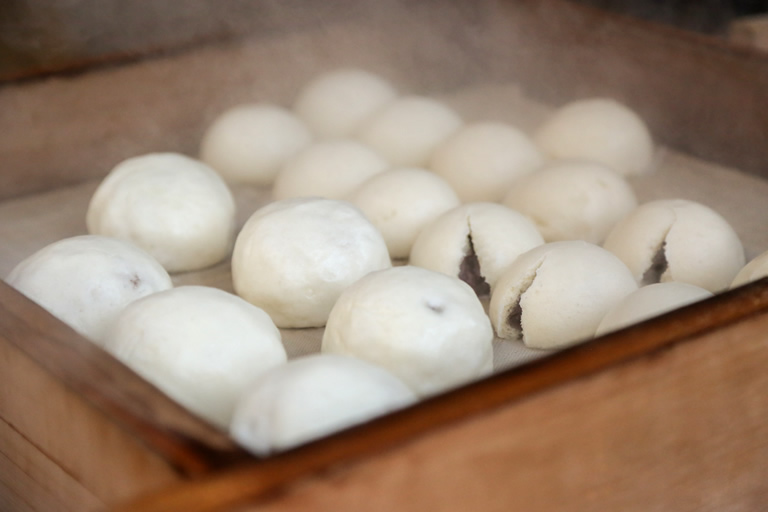
Manju filled with sweet paste. Enjoy it steaming hot. ©KOBE TOURISM BUREAU
As you trod along, you'll likely spot locals donning "yukata." The yukata is one of Japan’s traditional clothing. Yukata is made from fabric thinner than a kimono and is worn in more casual settings.
While modern Japanese reserve kimono and yukata for special occasions, it's still common in hot spring towns like Arima. Many hot spring town lodgings provide yukata for their guests, allowing them to cool off their bodies after a nice, hot bath. Some of these facilities even offer a choice of patterns, so choose the one you like, slip on a pair of "geta" sandals, and immerse yourself in the charming atmosphere of Arima's streets.
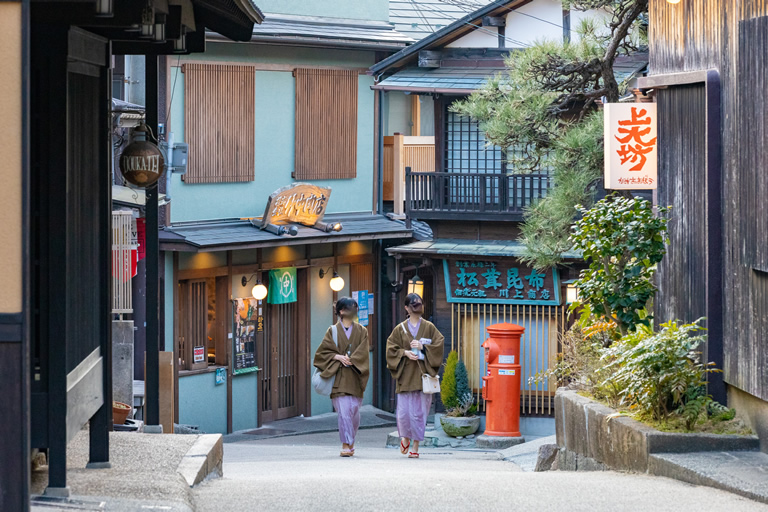
Encountering yukata-clad individuals is a quintessential sight unique to Japan’s hot spring towns. ©KOBE TOURISM BUREAU
Lodgings in hot spring towns often feature traditional Japanese rooms with tatami mats and sliding doors. Spend your time soaking in the hot springs, exploring the surroundings, and simply unwinding at your own pace. Each accommodation facility is staffed with "nakai-san" or hospitality professionals dedicated to ensuring your comfort. They guide you through the inn and town, serve meals, and prepare your bedding, embodying Japan's renowned spirit of hospitality. Indulge in seasonal delicacies crafted from local ingredients and savor the tranquility of your stay.
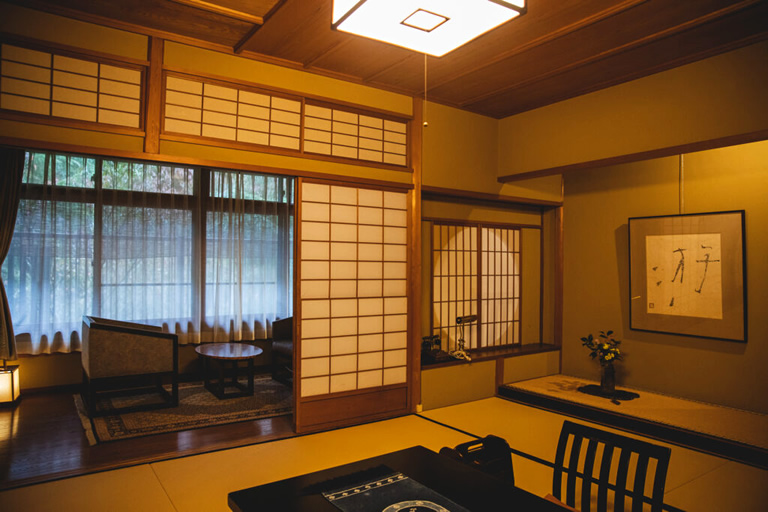
One of the perks of staying at a hot spring town is the chance to experience traditional Japanese room features like tatami mats and sliding doors.
Two Other Popular Hot Spring Areas in Hyogo
In addition to Arima Onsen, Hyogo Prefecture boasts two other beloved hot spring destinations: Kinosaki Onsen and Yumura Onsen.
Kinosaki Onsen is renowned for its diverse spring water properties and atmosphere, contributing to the popularity of "sotoyu meguri" (outdoor bath hopping). Once you check in to your lodgings, don your yukata and head out on an adventure. Along the river that flows through the heart of the town is a row of willow trees featuring stunning vistas with cherry blossoms in spring and breathtaking snowscapes in winter.
Yumura Onsen is distinguished by its piping-hot waters, reaching a scorching 98 degrees Celsius. Here, you can enjoy onsen tamago, eggs boiled in the plentiful hot spring water, and foot baths. The billowing steam rising from the hot springs creates an ambiance unique to hot spring towns.
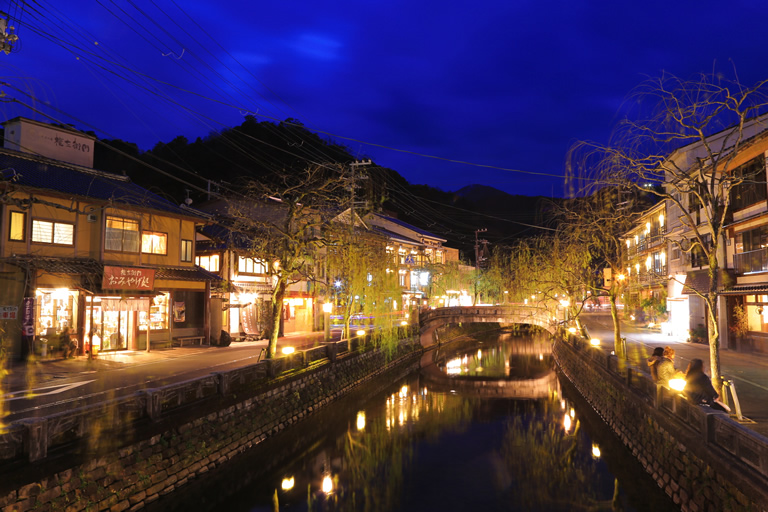
Kinosaki Onsen. The riverside hosts ryokan (traditional Japanese inns), souvenir shops, and more.
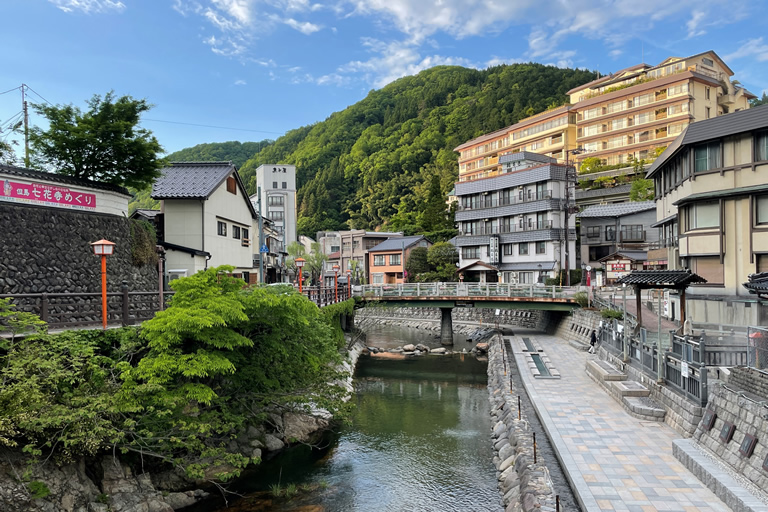
Yumura Onsen. Water with temperatures of 98 degrees Celsius, one of Japan’s hottest, bursts forth.
●Arima Onsen
https://www.hyogo-tourism.jp.e.atl.hp.transer.com/spot/0110
●Kin no Yu (Golden Spring)
https://www.hyogo-tourism.jp.e.atl.hp.transer.com/spot/113
●Gin no Yu (Silver Spring)
https://www.hyogo-tourism.jp.e.atl.hp.transer.com/universal/spot/9
●Kinosaki Onsen
https://www.hyogo-tourism.jp.e.atl.hp.transer.com/spot/0784
●Hyogo Field Pavilion: Modern and Traditional Kinosaki Onsen Town Tour (Guided Tour with Audio Commentary or Exploration with Old Paper Maps)
https://expo2025-hyogo-fieldpavilion.jp.e.atd.hp.transer.com/program/53
●Hyogo Field Pavilion: Journey to discover the stories of the storks
https://expo2025-hyogo-fieldpavilion.jp.e.atd.hp.transer.com/program/14
●Yumura Onsen
https://www.hyogo-tourism.jp.e.atl.hp.transer.com/spot/0732
Date : 2024.03.19



